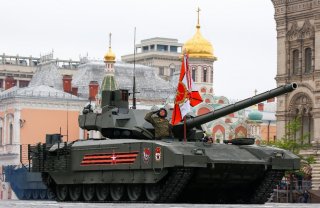The T-14 Armata Was a Long Time Coming But NATO's Tank Nightmare is Here
Russian designers are considering ways that the tank could be employed with no crew.
Here's What You Need to Remember: Russia had originally announced plans to acquire upwards of 2,300 T-14s by 2025, but given the high cost of each tank, Moscow has scaled back considerably.
Good things come to those who wait, and in the case of military hardware, some of the best things take time to finally enter service – at least in significant numbers. This is most certainly the case with the Russian military's T-14 Armata tank, which has truly been a slow time coming.
However, on Thursday Defense Minister Army General Sergei Shoigu said during a ministry conference call that a "pilot batch" of tanks, infantry fighting vehicles, and repair and evacuation equipment based on the Armata combat platform will be delivered to the Russian troops sometime next year.
In 2022, there are plans to deliver a pilot batch of T-14 tanks, T-15 infantry fighting vehicles and T-16 armored repair and evacuation hardware to the troops," Shoigu said, as reported by Tass.
In December, the Russian Ministry of Defense had announced that the serial production of Russia's "prospective military hardware," including the latest T-14 'Armata' main battle tank (MBT) as well as the T-15 infantry fighting vehicle, would begin before the completion of all trials. The goal was to speed up the delivery to the Russian armed forces.
Russia's Armata heavy tracked universal platform was developed to carry various hardware including the T-14 tanks, T-15 infantry fight vehicles and T-16 overhaul and evacuation armored vehicles. The T-14 had already undergone preliminary trials in 2019.
The new MBT, which differs fundamentally from its predecessors. The T-14, which was developed by Uralvagonzavod, was first demonstrated at the May 9, 2015, Victory Day parade in Moscow. It is a revolutionary design that features fully digitized equipment, along with an unmanned turret and an isolated armored capsule for the crew, which was designed to reduce the risk of personnel loss in combat.
Armata Tank: Amazing Capabilities, High Costs
Russia had originally announced plans to acquire upwards of 2,300 T-14s by 2025, but given the high cost of each tank, Moscow has scaled back considerably. Likewise, the arrival to troops has also been slow going and has become akin to "Waiting for Godot." One issue has been that the T-14 Armata is so revolutionary that it has its share of "teething problems," many of which are based on the design.
The crew compartment doesn't rotate with the turret and requires greater emphasis on optical equipment and electronics, which some analysts have warned could fail in battle – a potentially catastrophic situation if there ever was one. As a result of the costs and problems, Russia has opted to upgrade much of its existing tank fleet.
However, it has continued to press forward with the T-14 Armata and in the summer of 2020, it was announced that Russian designers were considering ways that the tank could be employed without a crew at all.
"The appearance of heavy unmanned combat vehicles is a matter of the near future," the T-14's manufacturer UralVagonZavod announced during the Army-2020 forum.
UralVagonZavod's Deputy General Director Vyacheslav Khalitov has previously stated that the company had carried out theoretical and experimental work to create a robotic tank on the Armata-heavy military tracked vehicle platform. It is also the first tank in the world to incorporate so-called “network-centric warfare” technologies. In normal speak this means that the T-14 can be conduct reconnaissance missions, operate as a target designation and fire adjustment vehicle for self-propelled guns, surface-to-air missile systems, and even T-90 tanks.
To offset the high costs of the tank, Russia has been seeking to find foreign customers for the T-14, and it was unveiled abroad at the IDEX 2021 arms show in Abu Dhabi last month.
Peter Suciu is a Michigan-based writer who has contributed to more than four dozen magazines, newspapers and websites. He regularly writes about military small arms, and is the author of several books on military headgear including A Gallery of Military Headdress, which is available on Amazon.com.
Image: Reuters

